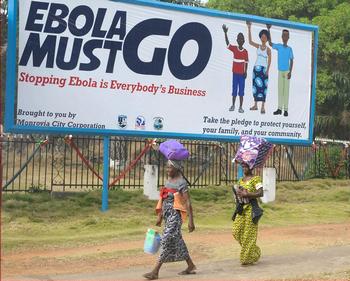
GENEVA, Switzerland, May 10, 2015 (ENS) – In Liberia, the country with the highest death toll in the worst outbreak of Ebola virus since it emerged in 1976, transmission of the disease has been stopped, at least for now, the World Health Organization said Saturday.
Forty-two days have passed since the last laboratory-confirmed case of the Ebola virus was buried on March 28, That means the outbreak of Ebola virus disease in Liberia is over, WHO said.

“It is a tribute to the government and people of Liberia that determination to defeat Ebola never wavered, courage never faltered,” WHO declared in a statement announcing the 42-day milestone and praising Liberian President Ellen Johnson Sirleaf for her handling of the crisis.
This Ebola virus outbreak began in March 2014 and to date has infected 10,564 people in Liberia, of whom 4,716 have died, according to data issued by the UN health agency.
WHO praised doctors and nurses who continued to treat patients, even when supplies of personal protective equipment and training in its safe use were inadequate.
Altogether, 375 health workers were infected with the Ebola virus – 189 lost their lives.
Local volunteers, who worked in treatment centers, on burial teams, or as ambulance drivers, were driven by a sense of community responsibility and patriotic duty to end Ebola and bring hope back to the country’s people.
As the number of cases grew exponentially, international assistance began to pour in, WHO explained. All these efforts helped push the number of cases down to zero,
Liberia’s last case was a woman in the greater Monrovia area who developed symptoms on March 20 and died seven days later. The source of her infection remains under investigation.
The 332 people who may have been exposed to the patient were identified and closely monitored. No one developed symptoms; all have been released from surveillance.
Health officials have maintained a high level of vigilance for new cases. During April, the country’s five dedicated Ebola laboratories tested around 300 samples every week. All test results were negative.

While WHO is confident that Liberia has “interrupted transmission,” of the deadly virus, outbreaks persist in neighboring Guinea and Sierra Leone, creating a high risk that infected people may cross into Liberia over what WHO termed “the region’s exceptionally porous borders.”
At the peak of transmission, which occurred during August and September 2014, Liberia reported 300 to 400 new cases every week.
Case numbers that had multiplied quickly began to grow exponentially. On August 6, President Ellen Johnson Sirleaf declared a three-month state of emergency and announced several strict measures aimed at getting cases down.
In the capital city Monrovia during those two months, gates were locked at overflowing treatment centers, patients were dying on the hospital grounds, and bodies were sometimes not collected for days.
Flights were cancelled. Fuel and food ran low. Schools, businesses, borders, markets, and most health facilities were closed. Fear and uncertainty about the future, for families, communities, and the country and its economy, dominated Liberia’s national mood.
Every one of Liberia’s 15 counties eventually reported cases. At one point, no treatment beds for Ebola patients were available anywhere in the country. With infectious cases and corpses remaining in homes and communities, spreading further infections.
Some expressed concern that the virus might become permanent in Liberia.
But Liberia was determined to eradicate it, and a combination of techniques has defeated the virus.
Liberia’s first two cases, in the northern county of Lofa near the border with Guinea, were confirmed on March 30, 2014.
In Lofa, staff from the WHO country office moved from village to village, challenging chiefs and religious leaders to take charge of the response.
Community task forces were formed to create house-to-house awareness, report suspected cases, call health teams for support, and conduct contact tracing.
See-through walls around the treatment center replaced opaque ones, allowing families and friends to watch what was happening inside, thus dispelling many rumors.
Calls for transportation to treatment facilities or for burial teams were answered quickly, building confidence that teams were there to help.

The effectiveness of this response, which was duplicated elsewhere, depended on generous support from the international community, in the form of financial, logistical and human resources.
This support added more treatment beds, increased laboratory capacity, and augmented the number of contact tracing and burial teams, said the WHO. Self-sufficient foreign medical teams from several countries “had a dramatic impact on the outbreak’s evolution,” the UN agency said.
Strong coordination of the international with the national response was essential. Innovations such as the Presidential Advisory Committee on Ebola and introduction of a incident management system helped ensure that resources and capacities were placed where needed, WHO explained.
Many of these lessons and experiences are reflected in WHO’s new response plan, released on April 28 , which aims to identify all remaining Ebola cases in West Africa by June 2015.
The Liberian government is fully aware of the need to remain on high alert and has the experience, capacity, and support from international partners to do so, said the UN agency.
WHO will maintain an enhanced staff presence in Liberia until the end of the year as the response transitions from outbreak control, to vigilance for imported cases, to the recovery of essential health services.
Copyright Environment News Service (ENS) 2015. All rights reserved.
© 2015, Environment News Service. All rights reserved. Content may be quoted only with proper attribution and a direct link to the original article. Full reproduction is prohibited.
